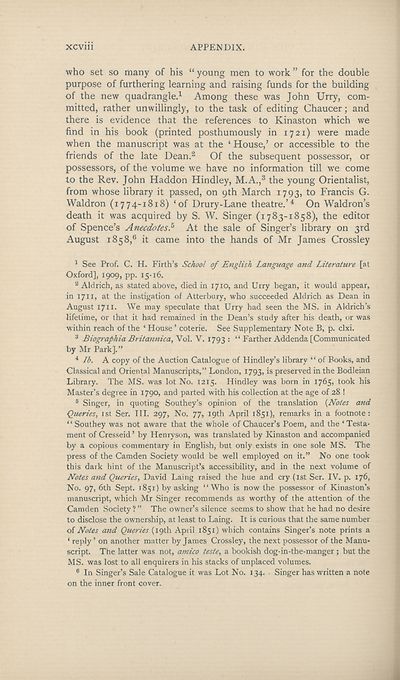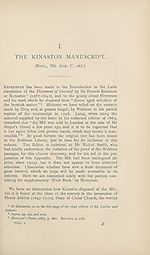Download files
Complete book:
Individual page:
Thumbnail gallery: Grid view | List view

XCV111
APPENDIX.
who set so many of his “ young men to work ” for the double
purpose of furthering learning and raising funds for the building
of the new quadrangle.1 Among these was John Urry, com¬
mitted, rather unwillingly, to the task of editing Chaucer; and
there is evidence that the references to Kinaston which we
find in his book (printed posthumously in 1721) were made
when the manuscript was at the ‘ House,’ or accessible to the
friends of the late Dean.2 Of the subsequent possessor, or
possessors, of the volume we have no information till we come
to the Rev. John Haddon Hindley, M.A.,3 the young Orientalist,
from whose library it passed, on 9th March 1793, to Francis G.
Waldron (1774-1818) ‘of Drury-Lane theatre.’4 On Waldron’s
death it was acquired by S. W. Singer (1783-1858), the editor
of Spence’s Anecdotes? At the sale of Singer’s library on 3rd
August 1858,6 it came into the hands of Mr James Crossley
1 See Prof. C. H. Firth’s School of English Language and Literature [at
Oxford], 1909, pp. 15-16.
2 Aldrich, as stated above, died in 1710, and Urry began, it would appear,
in 1711, at the instigation of Atterbury, who succeeded Aldrich as Dean in
August 1711. We may speculate that Urry had seen the MS. in Aldrich’s
lifetime, or that it had remained in the Dean’s study after his death, or was
within reach of the ‘House’ coterie. See Supplementary Note B, p. clxi.
3 Biographia Britannica, Vol. V. 1793 : “ Farther Addenda [Communicated
by Mr Park].”
4 lb. A copy of the Auction Catalogue of Hindley’s library “of Books, and
Classical and Oriental Manuscripts,” London, 1793, is preserved in the Bodleian
Library. The MS. was lot No. 1215. Hindley was born in 1765, took his
Master’s degree in 1790, and parted with his collection at the age of 28 !
5 Singer, in quoting Southey’s opinion of the translation {Notes and
Queries, 1st Ser. III. 297, No. 77, 19th April 1851), remarks in a footnote:
“Southey was not aware that the whole of Chaucer’s Poem, and the ‘Testa¬
ment of Cresseid’ by Henryson, was translated by Kinaston and accompanied
by a copious commentary in English, but only exists in one sole MS. The
press of the Camden Society would be well employed on it.” No one took
this dark hint of the Manuscript’s accessibility, and in the next volume of
Notes and Queries, David Laing raised the hue and cry (1st Ser. IV. p. 176,
No. 97, 6th Sept. 1851) by asking “Who is now the possessor of Kinaston's
manuscript, which Mr Singer recommends as worthy of the attention of the
Camden Society?” The owner’s silence seems to show that he had no desire
to disclose the ownership, at least to Laing. It is curious that the same number
of Notes and Queries (19th April 1851) which contains Singer’s note prints a
‘ reply ’ on another matter by James Crossley, the next possessor of the Manu¬
script. The latter was not, amico teste, a bookish dog-in-the-manger ; but the
MS. was lost to all enquirers in his stacks of unplaced volumes.
6 In Singer’s Sale Catalogue it vras Lot No. 134. Singer has written a note
on the inner front cover.
APPENDIX.
who set so many of his “ young men to work ” for the double
purpose of furthering learning and raising funds for the building
of the new quadrangle.1 Among these was John Urry, com¬
mitted, rather unwillingly, to the task of editing Chaucer; and
there is evidence that the references to Kinaston which we
find in his book (printed posthumously in 1721) were made
when the manuscript was at the ‘ House,’ or accessible to the
friends of the late Dean.2 Of the subsequent possessor, or
possessors, of the volume we have no information till we come
to the Rev. John Haddon Hindley, M.A.,3 the young Orientalist,
from whose library it passed, on 9th March 1793, to Francis G.
Waldron (1774-1818) ‘of Drury-Lane theatre.’4 On Waldron’s
death it was acquired by S. W. Singer (1783-1858), the editor
of Spence’s Anecdotes? At the sale of Singer’s library on 3rd
August 1858,6 it came into the hands of Mr James Crossley
1 See Prof. C. H. Firth’s School of English Language and Literature [at
Oxford], 1909, pp. 15-16.
2 Aldrich, as stated above, died in 1710, and Urry began, it would appear,
in 1711, at the instigation of Atterbury, who succeeded Aldrich as Dean in
August 1711. We may speculate that Urry had seen the MS. in Aldrich’s
lifetime, or that it had remained in the Dean’s study after his death, or was
within reach of the ‘House’ coterie. See Supplementary Note B, p. clxi.
3 Biographia Britannica, Vol. V. 1793 : “ Farther Addenda [Communicated
by Mr Park].”
4 lb. A copy of the Auction Catalogue of Hindley’s library “of Books, and
Classical and Oriental Manuscripts,” London, 1793, is preserved in the Bodleian
Library. The MS. was lot No. 1215. Hindley was born in 1765, took his
Master’s degree in 1790, and parted with his collection at the age of 28 !
5 Singer, in quoting Southey’s opinion of the translation {Notes and
Queries, 1st Ser. III. 297, No. 77, 19th April 1851), remarks in a footnote:
“Southey was not aware that the whole of Chaucer’s Poem, and the ‘Testa¬
ment of Cresseid’ by Henryson, was translated by Kinaston and accompanied
by a copious commentary in English, but only exists in one sole MS. The
press of the Camden Society would be well employed on it.” No one took
this dark hint of the Manuscript’s accessibility, and in the next volume of
Notes and Queries, David Laing raised the hue and cry (1st Ser. IV. p. 176,
No. 97, 6th Sept. 1851) by asking “Who is now the possessor of Kinaston's
manuscript, which Mr Singer recommends as worthy of the attention of the
Camden Society?” The owner’s silence seems to show that he had no desire
to disclose the ownership, at least to Laing. It is curious that the same number
of Notes and Queries (19th April 1851) which contains Singer’s note prints a
‘ reply ’ on another matter by James Crossley, the next possessor of the Manu¬
script. The latter was not, amico teste, a bookish dog-in-the-manger ; but the
MS. was lost to all enquirers in his stacks of unplaced volumes.
6 In Singer’s Sale Catalogue it vras Lot No. 134. Singer has written a note
on the inner front cover.
Set display mode to: Large image | Zoom image | Transcription
Images and transcriptions on this page, including medium image downloads, may be used under the Creative Commons Attribution 4.0 International Licence unless otherwise stated. ![]()
| Publications by Scottish clubs > Scottish Text Society publications > Old series > Poems of Robert Henryson > Volume 1, 1914 > (108) |
|---|
| Permanent URL | https://digital.nls.uk/107411471 |
|---|
| Shelfmark | SCS.STES1.64 |
|---|---|
| Attribution and copyright: |
|
| Description | Edited by G. Gregory Smith. |
|---|---|
| Shelfmark | SCS.STES1.64 and SCS.STES1.55 |
| Additional NLS resources: | |
| Description | A collection of over 100 Scottish texts dating from around 1400 to 1700. Most titles are in Scots, and include editions of poetry, drama, and prose by major Scottish writers such as John Barbour, William Dunbar, Gavin Douglas, and George Buchanan. Edited by a key scholarly publisher of Scotland's literary history, and published from the late 19th century onwards by the Scottish Text Society. Available here are STS series 1-3. |
|---|

